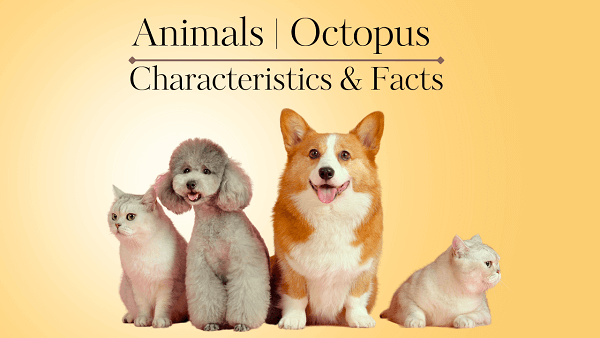Octopus Definition | Characteristics & Facts
Home » Animals » Octopus Definition | Characteristics & Facts
Octopus Definition
An octopus is a marine mollusk belonging to the class Cephalopoda. Octopuses are characterized by their soft bodies, eight arms (tentacles), and well-developed brains. They are known for their intelligence, adaptability, and remarkable camouflage abilities. Octopuses are found in oceans worldwide, inhabiting various depths and habitats, from coral reefs to the deep sea.
Octopus General Characteristics & Facts
- Octopuses are highly intelligent and fascinating creatures belonging to the order Octopoda, known for their soft bodies, eight flexible arms, and bulbous heads.
- They are found in oceans around the world, from shallow coastal waters to the deep sea, inhabiting diverse habitats such as coral reefs, rocky crevices, and sandy bottoms.
- Octopuses are known for their remarkable ability to change their skin color and texture, allowing them to camouflage with their surroundings and evade predators.
- They have no internal or external skeleton, which enables them to squeeze through small openings and crevices.
- Octopuses have a well-developed nervous system and complex behaviors. They exhibit problem-solving abilities, use tools, and have been observed displaying curiosity and learning from their environment.
- These cephalopods are predators, feeding on a variety of prey including crustaceans, fish, and mollusks. They use their arms to capture and manipulate their food.
- Octopuses have a remarkable defense mechanism called “ink sac,” which they use to release a cloud of dark ink when threatened, temporarily confusing predators and providing an opportunity for escape.
- Most octopuses have a short lifespan, typically living for a few years. However, there are exceptions, such as the giant Pacific octopus, which can live up to five years or longer.
- Reproduction in octopuses is fascinating. Males use a specialized arm called a hectocotylus to transfer sperm to females, and females lay large numbers of eggs that are carefully guarded and cared for until they hatch. After hatching, the female typically dies, as she stops eating to focus on caring for her eggs.
- Octopuses face various threats, including habitat destruction, overfishing, and climate change. Due to their sensitivity to environmental changes, they can serve as indicators of the health of marine ecosystems. Conservation efforts are essential to protect these remarkable creatures and their habitats.
Read our Animals Encyclopedia with Complete Facts
Physical Characteristics of Octopus
- Soft Body: Octopuses have a soft and flexible body without any internal or external skeleton. This allows them to squeeze through tight spaces and hide in crevices or burrows.
- Arms (Tentacles): Octopuses are equipped with eight arms, also known as tentacles, which are lined with suction cups. These arms are highly flexible and can be maneuvered independently, allowing octopuses to grasp objects, manipulate prey, and move with agility.
- Suckers: The undersides of an octopus’s arms are covered in circular suction cups called suckers. These suckers have muscular walls and are used for a variety of purposes, including grasping prey, exploring the environment, and adhering to surfaces.
- Beak-Like Mouth: Located at the center of their arms, octopuses have a beak-like mouth that they use to bite and tear apart their prey. The beak is made of hard, chitinous material and is the only hard structure in their body.
- Skin and Coloration: Octopus skin is soft and often covered in chromatophores, specialized pigment cells that allow them to change color and patterns. This remarkable ability to camouflage helps octopuses blend into their surroundings and avoid predators.
- Eyes: Octopuses have complex eyes with excellent vision. Their eyes are well-developed and similar in structure to vertebrate eyes, with a lens, retina, and iris. They have excellent depth perception and can discern colors and shapes.
- Mantle: The mantle is the main body region of an octopus. It contains vital organs, including the digestive system, reproductive organs, and gills for respiration. The mantle houses the octopus’s internal organs and propels water for locomotion through a siphon.
- Ink Defense Mechanism: When threatened, octopuses can release a cloud of ink from a specialized gland located near their ink sac. This ink serves as a visual distraction, allowing the octopus to escape from predators or potential threats.
Continue To Explore All Animals That Start With O
Scientific Classification of Octopus
Kingdom: Animalia (Animals)
Phylum: Mollusca (Mollusks)
Class: Cephalopoda (Cephalopods)
Order: Octopoda (Octopuses
Key Locations of Octopus
- Mediterranean Sea
- Indo-Pacific Region
- Atlantic Ocean
- Pacific Northwest, North America
- Coral Reefs
- Coastal Rocky Habitats
- Deep Sea
View All A-Z Animals List
Octopus FAQs
What does an octopus eat?
- Crustaceans
- Mollusks
- Fish and Small Marine Animals



